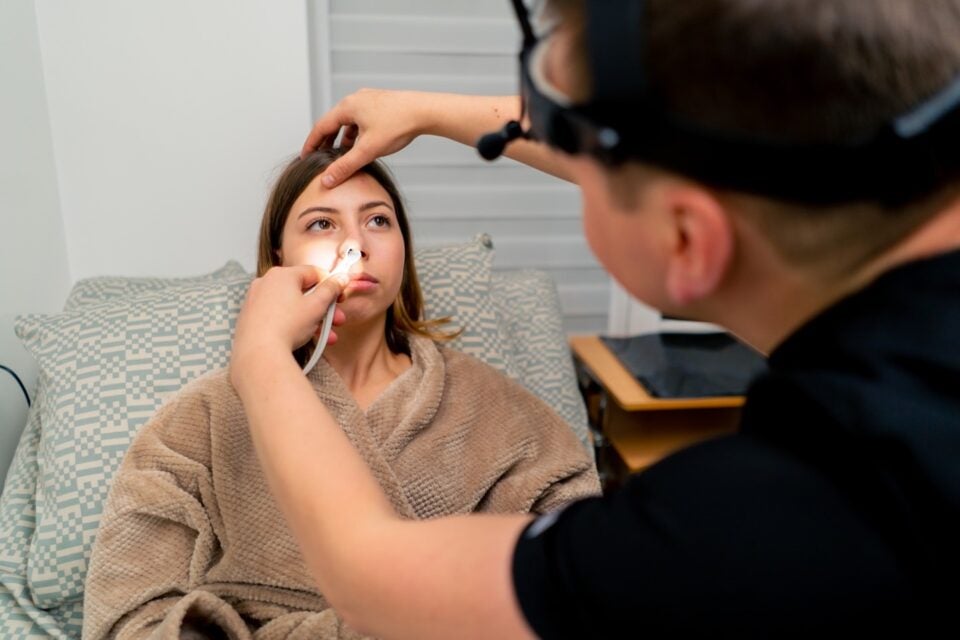Deviated Septum Treatment in Surprise, AZ
Nasal Septum Deviation is Our Specialty
Discover effective deviated septum treatment options at Oasis ENT in Surprise, AZ. With our expertise, we can address the challenges that arise from a deviated septum such as breathing difficulties, congestion and other discomforts. Utilizing advanced treatments such as minimally invasive procedures and tailored therapy plans, our team of specialists will help you find relief and enrich your overall well-being. A deviated septum can significantly impact your quality of life. Take the first step toward improved breathing and enhanced nasal health by scheduling a consultation today.

What is a Deviated Septum?
A deviated septum is an anatomical variation of the thin walls (nasal septum) separating the nostrils; those thin walls are displaced or shifted to one side. This common condition can be present at birth or can occur after an injury or trauma. Either way, a deviated septum can lead to breathing difficulties, cause nasal obstruction, snoring, and an increased susceptibility to sinus infections. The severity of the symptoms and the impact on a person’s life will determine the treatment option, which can range from medication to surgery.
Deviated Septum Causes
A deviated septum can have a variety of origins but it will often cause nasal obstruction and breathing difficulties. The most common causes of a deviated septum are:
- Congenital Displacement: A person can have a deviated septum from birth, while it occurs for others during fetal development.
- Trauma or Injury: A specific injury or trauma to the nose, such as breaking it, can lead to a deviated septum.
- Age-Related Changes: Aging can contribute to changes in nasal structure, potentially leading to a deviated septum.
Deviated Septum Symptoms
A deviated septum can present with a variety of symptoms, impacting nasal function and overall well-being. Here are the three common symptoms associated with a deviated septum:
- Nasal Congestion: The most common and persistent symptom of a deviated septum is nasal congestion. Breathing through one or both nostrils is challenging in the presence of nasal congestion and it will also lead to discomfort as well as difficulty maintaining clear nasal passages.
- Snoring and Sleep Disturbances: The disrupted airflow caused by the deviation can lead to noisy breathing patterns, affecting both the individual and their sleep partner.
- Recurrent Sinus Infections: The altered nasal airflow in conjunction with the obstruction caused by the deviation tends to create extra sinus congestion and inflammation, leading to frequent infections.
Diagnosis & Treatment of a Deviated Septum
In order to diagnose a deviated septum, a thorough examination by an ENT professional, often with the utilization of a nasal endoscope, will assess the nasal passages. We also evaluate your medical history and symptoms in the diagnostic process; symptom severity will determine the course of treatment. More mild cases may be managed with medications such as decongestants or nasal corticosteroid sprays to alleviate discomfort. More significant deviations that trigger unrelenting symptoms may require a surgical intervention known as septoplasty. Septoplasty aims to straighten the nasal septum, improving airflow and improving issues associated with the deviation such as nasal congestion and breathing difficulties.
What to Expect from Deviated Septum Surgery?
Septoplasty, the procedure available to correct a deviated septum, is common and will correct the misalignment of the nasal septum. Usually conducted as an outpatient procedure, septoplasty aims to straighten the septum, enhancing airflow and relieving associated symptoms. Incisions are made inside the nose in order to access, and then reposition, the septum. Recovery times for this procedure can vary but patients can generally expect temporary swelling, bruising, and nasal congestion. Typically, individuals experience relief in regards to breathing issues and nasal obstruction after the recovery period resulting in overall improved nasal function.
Contact Oasis Ear, Nose, and Throat
Rediscover life with unobstructed breathing after a visit at Oasis ENT. Our commitment to delivering comprehensive treatment for a deviated nasal septum goes beyond merely addressing symptoms; it’s about reinstating your ability to breathe freely and comfortably. Whether you’re dealing with a deviated septum or other nasal issues, our dedicated team is here to provide personalized care and lasting relief. Schedule an appointment with us to start your journey toward an improved quality of life.
